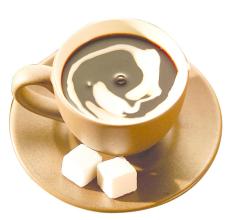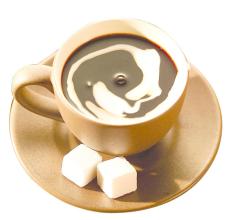Coffee flavor and taste characteristics of Silver Mountain Manor in Jamaica
The Blue Mountain region refers to the eastern part of Jamaica, and only coffee grown here can be called Jamaica Blue Mountain Coffee (JBM). Jamaica High Mountain coffee is ghostwritten to refer to coffee grown in the mountains outside the Blue Mountains region. Wallenford, Mavis, Old Tavern and Moy Hall are the four most famous legal Blue Mountain coffee green bean processing plants in Jamaica. But these four are not coffee farms, they are green coffee processing plants, do not grow their own coffee, but buy unprocessed coffee beans from small farms in the Blue Mountains region and process them according to official quality standards.
The flavor of a truly premium Jamaica Blue Mountain coffee is pure clean, mild, and soft, but that's where Blue Mountain coffee has a harder time roasting, just like other coffee beans grown on islands, even the best, highest altitude Jamaican coffee is not the highest altitude compared to other coffee grown at the highest altitude, and the lower altitude beans have a lower density, so there are different things to watch out for when roasting. If you lack experience roasting high-quality coffee, even if you buy great blue mountain green beans, you may also bake a pot of lifeless ordinary coffee. In addition, the rule of thumb for brewing Blue Mountain Coffee generally increases the amount of beans by 20% in order to get the rich and elegant aroma of Blue Mountain Coffee. This is also the reason why Blue Mountain Coffee needs to be sold more expensive.
Blue Mountain Coffee is the world's most superior coffee. The Blue Mountains are located in the eastern part of Jamaica Island. They are surrounded by the Caribbean Sea. Whenever the weather is clear, the sun shines directly on the blue sea, and the peaks reflect the bright blue light of the sea. Therefore, they are named. Blue Mountain peak elevation of 2256 meters, is the highest peak in the Caribbean, is also a famous tourist attraction. Located in the coffee belt, it has fertile volcanic soil, fresh air, no pollution, humid climate, foggy and rainy all year round (average precipitation is 1980 mm, temperature is about 27 degrees). This climate has created the world-famous Jamaica Blue Mountain Coffee and also created the highest price coffee in the world. This kind of coffee has all the characteristics of good coffee, not only the taste is rich and mellow, but also because the sweet, sour and bitter flavors of coffee are perfectly matched, so there is no bitterness at all, only moderate and perfect sourness. Generally, they are consumed as a single item, but due to the extremely low yield and extremely expensive price, the real Blue Mountain coffee is generally prepared with coffee with similar taste on the market, which is made from the best local green coffee beans. This is where the fun of tasting home lies. Its rich flavor, balance, rich fruit flavor and sour, can meet people's various needs. In addition, the flavor of high-quality fresh Blue Mountain coffee is particularly long-lasting, as drinkers say-endless aftertaste.
A closer look at the myth of Blue Mountain coffee is necessary because images of the past and reality of today often do not coincide. In 1725 Sir Nicholas Lawes brought the first Blue Mountain coffee seeds from Martinique to Jamaica, where they were planted in St Andrew. Today St. Andrew's is still one of the top three growing regions for Blue Mountain coffee, the other two being Portland and St. Thomas. Thomas) producing area. Within eight years, Jamaica exported more than 375 tons of pure coffee. Coffee production peaked in 1932, harvesting more than 15000 tons of coffee.
But by 1948, coffee quality had declined and Canadian buyers refused to renew the contract, so the Jamaica government set up the Coffee Industry Council to save the fate of premium coffee. By 1969, the situation had improved, as Japanese loans had improved the quality of production and thus secured the market. Even in 1969, Japanese coffee drinkers were willing to pay insurance for the coffee, but today it has reached the point where it is a cult favorite

Important Notice :
前街咖啡 FrontStreet Coffee has moved to new addredd:
FrontStreet Coffee Address: 315,Donghua East Road,GuangZhou
Tel:020 38364473
- Prev

Introduction of Coffee Flavor and Taste varieties in Atlanta Manor, Jamaica
When it comes to Jamaica, everyone's eyes lit up immediately because it produced the best Jamaican Blue Mountain Coffee (Jamaica Blue Mountain) in the world. We absolutely believe that Jamaica Blue Mountain Coffee is the best coffee, its acid, sugar, alcohol and bitterness are well balanced, fragrant and smooth to drink, but its price is too high, although it is worth a try, there is no need to do so.
- Next

Introduction to the Flavor and Taste characteristics of Coffee varieties in Cliff Manor, Jamaica
In 1670, according to the Madrid Treaty, Spain formally ceded Jamaica and other places to Britain. The British immediately used the island of Jamaica as a base for their acts of piracy. Before the earthquake destroyed the port of Loire in 1692, it was once the capital of pirates in the Caribbean. Since then, the British built Kingston and gradually built it into the central city of Jamaica after 1872.
Related
- Does Rose Summer choose Blue, Green or Red? Detailed explanation of Rose Summer Coffee plots and Classification in Panamanian Jade Manor
- What is the difference between the origin, producing area, processing plant, cooperative and manor of coffee beans?
- How fine does the espresso powder fit? how to grind the espresso?
- Sca coffee roasting degree color card coffee roasting degree 8 roasting color values what do you mean?
- The practice of lattes: how to make lattes at home
- Introduction to Indonesian Fine Coffee beans-- Java Coffee producing area of Indonesian Arabica Coffee
- How much will the flavor of light and medium roasted rose summer be expressed? What baking level is rose summer suitable for?
- Introduction to the characteristics of washing, sun-drying or wet-planing coffee commonly used in Mantenin, Indonesia
- Price characteristics of Arabica Coffee Bean Starbucks introduction to Manning Coffee Bean Taste producing area Variety Manor
- What is the authentic Yega flavor? What are the flavor characteristics of the really excellent Yejasuffi coffee beans?

